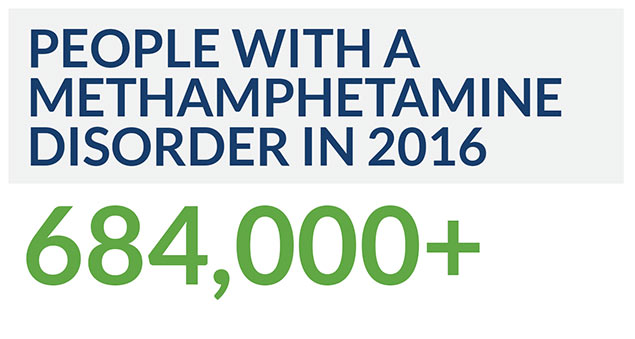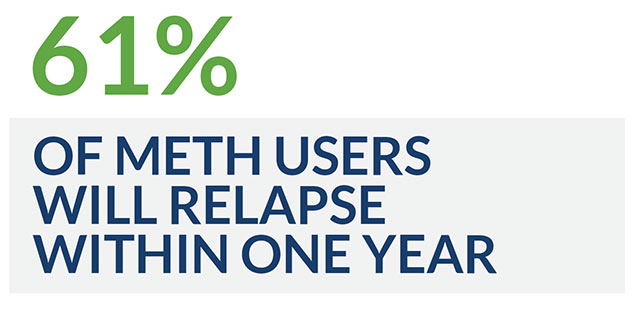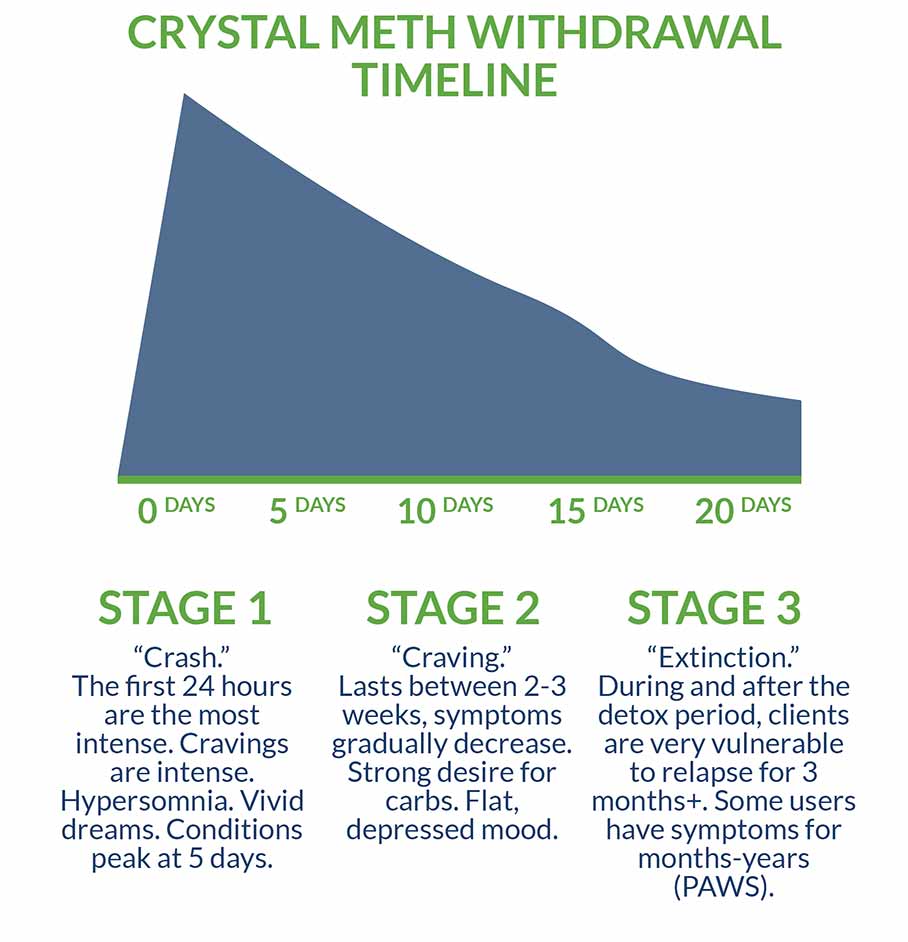Crystal Meth Detox Guide
[one-half-first]
There are no legal uses for crystal methamphetamine, also called crystal meth, “ice” or “glass.” Methamphetamine, however, has a long history, originally given to soldiers during World War II to keep them awake. Meth has been used for weight loss and depression, although the only current legal meth use is a tablet rarely prescribed for the treatment of obesity and attention-deficit-hyperactivity disorder (ADHD). Today, crystal meth, the illegally produced form of methamphetamine, is a popular party drug that comes in either shiny blue-white rocks or clear crystal chunks. The drug is highly addictive, even after a single use.
[/one-half-first]
[one-half]
Table of Contents
- Introduction to Crystal Meth Detox
- Crystal Meth Withdrawal Symptoms
- Crystal Meth Withdrawal Timeline
- Inpatient Treatment for Crystal Meth
- Outpatient Treatment for Crystal Meth
- Can Crystal Meth Detox Be Done at Home?
- Tapered vs. Cold Turkey
- Considerations for Crystal Meth Detox
- Recovery Success and Aftercare Services for Crystal Meth
[/one-half][clearfix]
Crystal meth is a stimulant affecting the central nervous system. So-called “meth labs” illegally manufacture crystal meth by mixing various over-the-counter ingredients with poisonous, corrosive and carcinogenic chemicals, including acetone, battery acid, bleach, lead, and red phosphorus, among others. Users typically place the drug in a small glass pipe and smoke it, although it is also often snorted, swallowed, or injected into a vein. It stimulates the central nervous system to produce a quick rush of euphoria.

Is meth ruining your life? Call: (855) 935-2871
CRYSTAL METH WITHDRAWAL SYMPTOMS
Withdrawal from crystal meth may be characterized by the following withdrawal symptoms:
[one-half-first]
- Agitation
- Depression
- Drug cravings, often intolerable and precipitating relapse
- Fatigue
- Insomnia or hypersomnia
- Increased appetite
[/one-half-first]
[one-half]
- Poor concentration
- Psychomotor impairment
- Psychosis
- Suicidal thoughts
- Unease or general dissatisfaction with life
[/one-half][clearfix]
While crystal meth withdrawal in and of itself rarely causes life-threatening physical symptoms, its mental–emotional effects can drive people to act in violent or dangerous behavior or even think about and attempt suicide.
The intensity and duration of withdrawal from crystal meth, as with any drug of abuse, can vary and is affected by several factors: the length of time the person has been addicted to the drug, regular dosage size, quality of meth used, where detox occurs (setting), age (older people may have a harder time with withdrawal), history of other drug use (including alcohol), mental and physical health before and during crystal meth use, and the presence of any co-occurring mental disorders, including clinical depression.
CRYSTAL METH WITHDRAWAL TIMELINE
Crystal meth withdrawal is a process that involves a predictable set of symptoms that begin shortly after discontinuing use of the drug. Withdrawal from crystal meth consists of physical and psychological symptoms, with the physical withdrawal manifestations wearing off much quicker than the psychological ones. Withdrawal typically occurs in phases:
- Phase One – CRASH: The most intense symptoms generally manifest during the first 24 hours and gradually get less intense over a two-week period. Cravings are intense during this time. In phase one of withdrawal, it’s common to experience sleepiness, tiredness, and fatigue. This condition usually peaks around day 5, with patients sleeping about 11 hours per day, a condition called hypersomnia. Vivid dreams are also commonly experienced during the first week of withdrawal. Some patients have psychotic symptoms, primarily hallucinations or delusions. These are usually gone after the first week of withdrawal.
- Phase Two – CRAVING: During phase two, lasting between 2-3 weeks, symptoms lessen in intensity, gradually wearing off. Craving frequency and intensity begin to subside over a period of 2-10 weeks. Clients begin to experience a strong desire to consume carbohydrates as their appetite returns. A flat or depressed mood, common in early days of crystal meth withdrawal, subsides for two-thirds of meth users by the second week, while for others it generally goes away after three weeks. Some chronic crystal meth users, however, experience long-term depression.
- Some users continue to have withdrawal symptoms for months or years. This is known as post-acute withdrawal syndrome (PAWS).
- Phase Three – EXTINCTION: During and after the detox period, clients withdrawing from crystal meth are highly vulnerable to relapse and should be involved in treatment, continuing for three months and beyond.
INPATIENT TREATMENT FOR CRYSTAL METH
For anyone who wants to overcome crystal meth dependence or addiction, it often comes down to the preliminary decision to choose inpatient or outpatient treatment. Both crystal meth treatment forms can last up to three months or longer, involve clinical and medical therapy, and may include:
- Medical checkups, exercise and wellness programs, and diet planning, including nutritional guidelines, healthy eating, and vitamins.
- Behavioral therapies, mainly the Matrix Method, a 16-week program of individual and group therapy that includes elements of relapse prevention, family communication, healthy environments, behavioral changes, and other elements related to abstinence from meth use.
- Contingency Management.
- Motivational Incentives for Enhancing Drug Abuse Recovery (MIEDAR), another behavioral treatment, helps meth users with abstinence. In clinical trials of MIEDAR, participants were twice as likely to achieve sustained (8 weeks) abstinence than patients receiving treatment as usual.
- 12-Step facilitation therapy. Hearing stories of others in recovery is a major form of support for those committed to overcoming crystal meth addiction.
Inpatient treatment, also known as residential treatment and inpatient rehab, involves residing in a 24/7 medically-supervised facility for a three-month or longer period. Where inpatient care is highly recommended is for those individuals who:
- Went through detox before (whether at self-detoxing at home or in a hospital or other clinical detox facility) and quickly relapsed upon return home and resumption of normal activities.
- Have any co-occurring mental health disorders that need to be addressed through treatment. This includes psychosis that existed before the use of crystal meth as well as methamphetamine-associated psychosis that began as a result of meth use.
- Come from a family with a history of chemical addictions, mental illness or suicide.
- Lack of a strong or sufficient support network independent of the treatment center.
One of the most compelling arguments for inpatient care is the fact that the client remains in a supportive environment away from the constant or recurring temptations and triggers to relapse. With residential treatment, highly-trained medical professionals and staff are always available to help with any physical or emotional needs.
Research published in the Journal of Addiction Medicine showed that an eight-week regimen of aerobic exercise training in MA-dependent patients in residential rehab showed significant improvement in performance, muscle strength and endurance, and body composition. Since crystal meth addiction often leaves the user gaunt, malnourished and in poor overall health, therapy that helps the client recover in physical condition metrics can aid in recovery prospects long-term.
Learn more about Inpatient Crystal Meth Rehab
OUTPATIENT TREATMENT FOR CRYSTAL METH
Options for outpatient care can vary, from sending clients back to their normal residences and requiring they come back for three-hour appointments on a three-day-a-week schedule, to providing housing on the campus of the detox center and including lengthy therapy sessions occurring five to seven days a week. At some centers, newly detoxed crystal meth patients may start off in a shorter inpatient program (for example, 35 days) before transitioning to an outpatient program.
Outpatient care may be preferable for someone who:
- Finds the stress of unfamiliar people and settings overly disconcerting, thus distracting from treatment goals.
- Can generally function normally in outside responsibilities, such as work, and isn’t regularly exposed to crystal meth-use triggers in such settings. It is, however, important to avoid selecting outpatient crystal meth treatment based on an overriding concern about being away from work too long.
- Has an established network of family and friends who can provide ongoing support and encouragement.
- Lives close by the most appropriate and best outpatient treatment option. If the treatment center is inconveniently located, you’re more vulnerable to letting your treatment attendance lapse, particularly when treatment is scheduled at the end of a long day.
Learn more about Outpatient Crystal Meth Rehab
CAN CRYSTAL METH DETOX BE DONE AT HOME?
Since withdrawal symptoms for crystal meth addiction may be unpleasant at best and significantly uncomfortable or worse, it’s never advisable to attempt crystal meth detox at home. For this reason, among others, crystal meth detox should always take place in an inpatient detox or residential detox and treatment setting. Granted, some individuals have done an at-home crystal meth detox, yet this poses serious risks, especially for those who also have a co-occurring mental health disorder or have previously attempted or talked about suicide.
Even when crystal meth has been used for only a short period of time, the user is in overall good health and has a reliable support system in place, medically supervised inpatient treatment is preferable because:
- A detox center has the facilities to make clients as comfortable as possible. Withdrawal from stimulant dependence and addiction shouldn’t be a nightmare. Knowing that your comfort is a top concern is both reassuring and motivating.
- Since you may experience various symptoms during withdrawal from crystal meth, some of which may be serious, you’ll want to ensure you have certified detox counselors there who are best qualified to help deal with those symptoms.
- Recognizing and defusing medical dangers by well-trained detox staff is paramount.
- Most of the symptoms during crystal meth detox have been seen before by detox staff. These highly-trained experts will reassure you that what you’re experiencing is common, yet will not last forever.
While there are no current FDA-approved medications for treating methamphetamine addiction, detox centers, and inpatient or residential treatment centers have licensed physicians who can prescribe various treatment approaches. This may entail a regimen of vitamins to restore the body’s vitality and prescribing medications to help alleviate symptoms of depression, anxiety, PTSD, psychoses, and other mental health disorder diagnoses. However, some medications currently under study or in clinical trials show potential to reduce the intensity of crystal meth withdrawal symptoms and risk of relapse:
- Bupropion (an antidepressant, marketed as Wellbutrin), was found significantly effective in clinical trials in reducing meth abuse, in reducing acute meth-induced subjective effects and cue-induced cravings.
- Topiramate, an anti-epileptic medication, had shown promise in Phase II trials with outpatient meth-addicted patients.
- One study with another epilepsy drug, gamma-vinyl GABA (GVG), showed that half of the patients treated with it were drug-free at 6 weeks, despite living at home and having ready access to drugs.
- Research continues regarding the ability of newer generations of monoclonal antibody-based medications to quickly reverse meth effects in hospital emergency rooms and reverse or prevent medical problems long-term.
- Modafinil, noted for its wake-promoting properties, ability to decrease food intake, and the fact that it does not increase heart rate, showed promise as a medication for acute methamphetamine withdrawal in a clinical trial. Larger trials are needed to establish efficacy.
- A clinical trial of methylphenidate and resperidone found that both medications lowered drug cravings in meth-dependent patients, although resperidone was more effective in this area. Both drugs also reduced psychological, neurological and somatic problems in patients. Researchers concluded that both medications can be successfully used to treat MA dependence.
- Researchers are also studying gene therapy as an adjunct to behavioral therapy to help to recover meth addicts to prevent relapse.
- Various research studies are underway, some partly funded by the National Institute on Drug Abuse (NIDA) to identify and test a “meth vaccine” for safety and efficacy potential to reduce relapse.
TAPERED VS. COLD TURKEY
Unlike some drugs of abuse, for which detox may require a gradual, more tapered approach, “cold turkey” is the preferred approach for detoxing from crystal meth. When detox is supervised by medical professionals, certain prescription medications can be administered to alleviate specific withdrawal symptoms, including drugs to ease depression, anxiety, suicidal thoughts, and other medical issues.
CONSIDERATIONS/HOW TO DECIDE WHAT IS RIGHT FOR YOU
There is never a single consideration in helping you decide on the choice of a treatment program. Instead, there are several factors to carefully weigh. First and foremost, identify the types of inpatient or outpatient options and various medical process approaches to treatment. Other points to consider include:
- Treatment facility location (generally speaking, treatment facilities located close to you are best).
- What is the overall philosophical approach of the treatment facility?
- Treatment center’s reputation in the field of addiction treatment and its involvement in the community.
- Does the treatment facility have experience treating crystal meth addiction specifically?
Depending on treatment methods, additional facilities provided and individual patient needs, crystal meth detox and rehab can be expensive. However, most health insurance policies, including services provided through the Veterans Affairs Department, will take care of at least part of the expenses for addiction treatment. Also important is the fact that some healthcare costs may be tax deductible. Fortunately, most health insurance policies, including Veterans Affairs, cover at least part of addiction-treatment expenses. Some healthcare costs are even tax deductible, although neither tax considerations nor affordability should ever stand in the way of getting treatment.
RECOVERY SUCCESS AND AFTERCARE SERVICES FOR CRYSTAL METH

Research shows that individuals with methamphetamine use disorder (MA) have “unique brain activity” when exposed to MA-related cues – even after long-term drug rehab. Although not as well studied, researchers found that libido brain response may be restored following long-term MA rehab. To help maximize your chances of sustainable recovery, it is imperative that you identify and put into practice alternative techniques to manage stress and find pleasure in life.
Among these techniques are ongoing therapy, continuing treatment for co-occurring illnesses, and regular participation in support groups. In fact, participation in peer support groups and the ability to interact with and share stories of recovery, according to self-reports by over 80 percent of such participants, help promote empathy and accountability to reduce relapse temptation. Other characteristic elements of effective aftercare include:
- Drug testing to ensure you’re free of addictive substances.
- Social events to make you feel included, supported and conducive to healthier lifestyle behavior.
- Readily-available help in the event you experience intense temptation or actual relapse.
Learn more about Crystal Meth Aftercare
For more about crystal meth detox and recovery, check out these related articles:
- “The Truth About Relapse Rates and Addiction Recovery”
- “Drug Detox and Addiction Programs”
- “Rehab for Veterans: Things to Consider When Finding a Treatment Center”
- “Choosing Between Inpatient and Outpatient Treatment”
- “Is Addiction Genetic? How Genetic Predisposition Can Play a Role in Addiction”
- “The Benefits of Inpatient Rehab”
Is meth ruining your life? Get help now
[expand title=" Sources:" targclass="highlight"]
Addiction. “The prevalence of psychotic symptoms among methamphetamine users.” Retrieved from https://www.ncbi.nlm.nih.gov/pubmed/16968349/
Biological Psychiatry. “A Methamphetamine Vaccine Attenuates Methamphetamine-Induced Disruptions in Thermoregulation and Activity in Rats.” Retrieved from https://www.biologicalpsychiatryjournal.com/article/S0006-3223(12)00803-7/abstract
ClinicalTrials.gov. “Study of Medical Treatment for Methamphetamine Addiction (BUP PGx).” Retrieved from https://clinicaltrials.gov/ct2/show/study/NCT00833443?term=%22Methamphetamine%22+and+%22Addiction%22&rank=2§=Xa80156
Drug and Alcohol Dependence. “Time to relapse following treatment for methamphetamine use: a long-term perspective on patterns and predictors.” Retrieved from https://www.ncbi.nlm.nih.gov/pmc/articles/PMC4550209/
Drug and Alcohol Review. “A pilot randomized controlled trial of modafinil during acute methamphetamine withdrawal: Feasibility, tolerability, and clinical outcomes.” Retrieved from https://onlinelibrary.wiley.com/doi/full/10.1111/j.1465-3362.2012.00473.x
Frontiers in Psychiatry. “Craving Responses to Methamphetamine and Sexual Visual Cues in Individuals with Methamphetamine Use Disorder after Long-Term Drug Rehabilitation.” Retrieved from https://www.ncbi.nlm.nih.gov/pmc/articles/PMC5917670/
International Journal of Medical Sciences. “Recombinant AAV8-mediated intrastriatal gene delivery of CDNF protects rats against methamphetamine neurotoxicity.” Retrieved from https://www.ncbi.nlm.nih.gov/pubmed/28553166
Journal of Addiction Medicine. “Eight Weeks of Exercise Training Improves Fitness Measures in Methamphetamine-Dependent Individuals in Residential Treatment.” Retrieved from https://journals.lww.com/journaladdictionmedicine/Abstract/2013/03000/Eight_Weeks_of_Exercise_Training_Improves_Fitness.7.aspx
Journal of Addiction Medicine. “Sex Differences in the Association Between Internalizing Symptoms and Craving in Methamphetamine Users.” Retrieved from https://journals.lww.com/journaladdictionmedicine/Abstract/2016/12000/Sex_Differences_in_the_Association_Between.4.aspx
Journal of Neuroimmune Pharmacology. “Methamphetamine-Associated Psychosis.” Retrieved from https://www.ncbi.nlm.nih.gov/pmc/articles/PMC3280383/
Journal of Neurology, Neurosurgery & Psychiatry. “Stroke and methamphetamine use in young adults: a review.” Retrieved from https://jnnp.bmj.com/content/88/12/1079
MedlinePlus. “Methamphetamine overdose.” Retrieved from https://medlineplus.gov/ency/article/007480.htm
National Institute on Drug Abuse. “Availability and Effectiveness of Programs to Treat Methamphetamine Abuse.” Retrieved from https://archives.drugabuse.gov/testimonies/2006/availability-effectiveness-programs-to-treat-methamphetamine-abuse
National Institute on Drug Abuse. “High rates of dental and gum disease occur among methamphetamine users.” Retrieved from https://www.drugabuse.gov/news-events/news-releases/2015/11/high-rates-dental-gum-disease-occur-among-methamphetamine-users
National Institute on Drug Abuse. “Methamphetamine.” Retrieved from https://www.drugabuse.gov/drugs-abuse/methamphetamine
Saudi Pharmaceutical Journal. “Methylphenidate vs. resperidone in treatment of methamphetamine dependence: A clinical trial.” Retrieved from https://www.sciencedirect.com/science/article/pii/S1319016413000418
Substance Abuse and Mental Health Services Administration. “Key Substance Use and Mental Health Indicators in the United States: Results from the 2016 National Survey on Drug Use and Health.” Retrieved from https://www.samhsa.gov/data/sites/default/files/NSDUH-FFR1-2016/NSDUH-FFR1-2016.htm#illicit12
Substance Abuse and Rehabilitation. “Benefits of Peer Support Groups in the Treatment of Addiction.” Retrieved from https://www.ncbi.nlm.nih.gov/pmc/articles/PMC5047716/
Synapse. “Racemic gamma-vinyl-GABA (R,S-GVG) blocks methamphetamine-triggered reinstatement of conditioned place preference.” Retrieved from https://www.ncbi.nlm.nih.gov/pubmed/19016239
[/expand]



